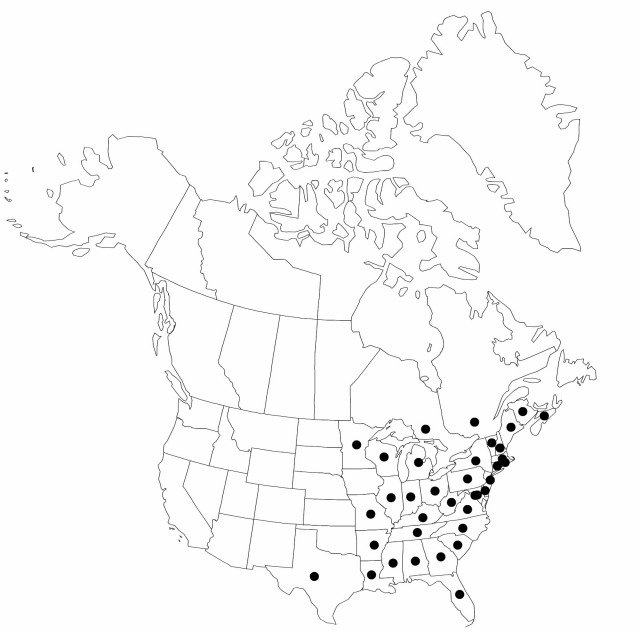Carex bromoides
Sp. Pl. 4(1): 258. 1805.
Plants densely to loosely cespitose. Culms 23–88 cm × 0.5–1.6 mm, smooth. Leaves: ligules 1–3.5 mm, 1–3 times as long as wide; blades 1.1–4.4 mm wide, widest blade 1.3–4.4 mm wide. Inflorescences (12–)21–63(–71) mm; proximal internode 3.3–16(–23) mm; proximal bracts 5–24(–28) mm, awn 1.3–19 mm; spikes 3–8, usually gynecandrous, sometimes also pistillate, staminate or with pistillate and staminate flowers scattered throughout; proximal spikes with 0–2 staminate and 9–19 pistillate flowers, 10–17(–20) × 1.8–5 mm; terminal spikes usually with 0–3 staminate and 8–18 pistillate flowers, 9–20(–25) × 1.5–5 mm. Pistillate scales with pale to red-brown margins, 2.8–4.1 × 1.1–1.6 mm, apex acuminate or with awn to 0.6 mm. Staminate scales with pale to red-brown margins, 2.8–3.9 × 1.4–1.6 mm, apex acute to acuminate. Anthers 1.7–2.9 mm. Perigynia erect, green to pale brown, (3–)4–8-veined abaxially, prominently to weakly 3–6-veined adaxially, narrowly lanceolate, (3.3–)4.1–6.7 × 0.8–1.3 mm, (3.5–)4–6.1(–6.6) times as long as wide, apex abruptly contracted or gradually tapering; beak 1.2–2.2(–2.8) mm, 0.28–0.51 times as long as perigynia, margins serrulate, apex entire or bidentulate, teeth to 0.2 mm, 0–0.05 times as long as perigynia. Stigmas 2–3.4 mm. Achenes 1.7–2.2 × 0.7–1.1 mm, 1.9–2.9 times as long as wide.
Distribution

North America, Mexico.
Discussion
Subspecies 2 (2 in the flora).
Selected References
Key
| 1 | Culms 0.5–1(–1.1) mm wide; widest leaf blades 1.3–2.9(–3.1) mm wide; perigynium beak 0.3–0.42 times as long as perigynium. | Carex bromoides subsp. bromoides |
| 1 | Culms 1–1.6 mm wide; widest leaf blades 2.8–4.4 mm wide; perigynium beak 0.36–0.48 times as long as perigynium. | Carex bromoides subsp. montana |